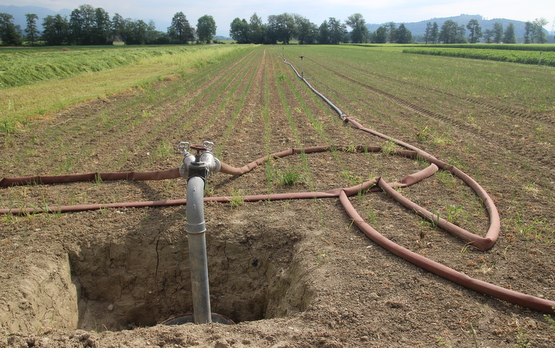Climatic and socio-economic changes are contributing to changes in the demand for water for agricultural irrigation. As the "water castle” of Europe, Switzerland basically has abundant water resources. However, even under current climatic conditions, extreme dry periods repeatedly lead to regional and temporary irrigation bans. For example, farmers in some regions of Switzerland were unable to irrigate during periods of extreme drought such as those that occurred in 2003, but also in 2015 and 2018, and had to accept yield losses. Based on the expected climatic changes alone, it must be assumed that situations such as these will become increasingly common in the future. In response to this, farmers are forming irrigation cooperatives in order to implement extensive irrigation projects. The aim is to ensure the water supply even in extremely dry years (e.g. by pumping from larger lakes or rivers in the vicinity or from the groundwater).
Against the background of progressing climate change and the associated changes in agricultural water use, the question of the long-term resilience of environmental systems arises. What effects on water availability can be expected? Could water use conflicts develop or intensify (e.g. between drinking water use and agricultural irrigation)?
In order to get to the bottom of such questions, Agroscope, as part of the AgriAdapt project financed by the Federal Office for the Environment, and in collaboration with the Universities of Bern and Neuchâtel, investigated the effects that changes in agricultural water use in conjunction with climate change could have on groundwater resources in the Bernese Seeland. An integrated modelling approach was used, linking complex mechanistic models from different disciplines (a plant growth model, a hydrological model, a geohydrological model). The model system was calibrated and validated for the aquifer in the Bernese Seeland.
Model results show that by the end of the century the irrigation demand will increase by up to 40% on average (without effective climate protection measures (RCP8.5)). This is assuming that the cultivation period in the future will remain roughly the same as it is today. If the cultivation period is extended to adapt to warmer conditions, the water demand for irrigation could even increase by 80%. With an additional expansion of irrigated land, the water demand for irrigation in the region could easily multiply. If more water for irrigation were to be extracted from the aquifer, this would contribute to pronounced seasonal fluctuations in the groundwater level. This can lead to an intensification of conflicts of use with drinking water use and nature conservation.






